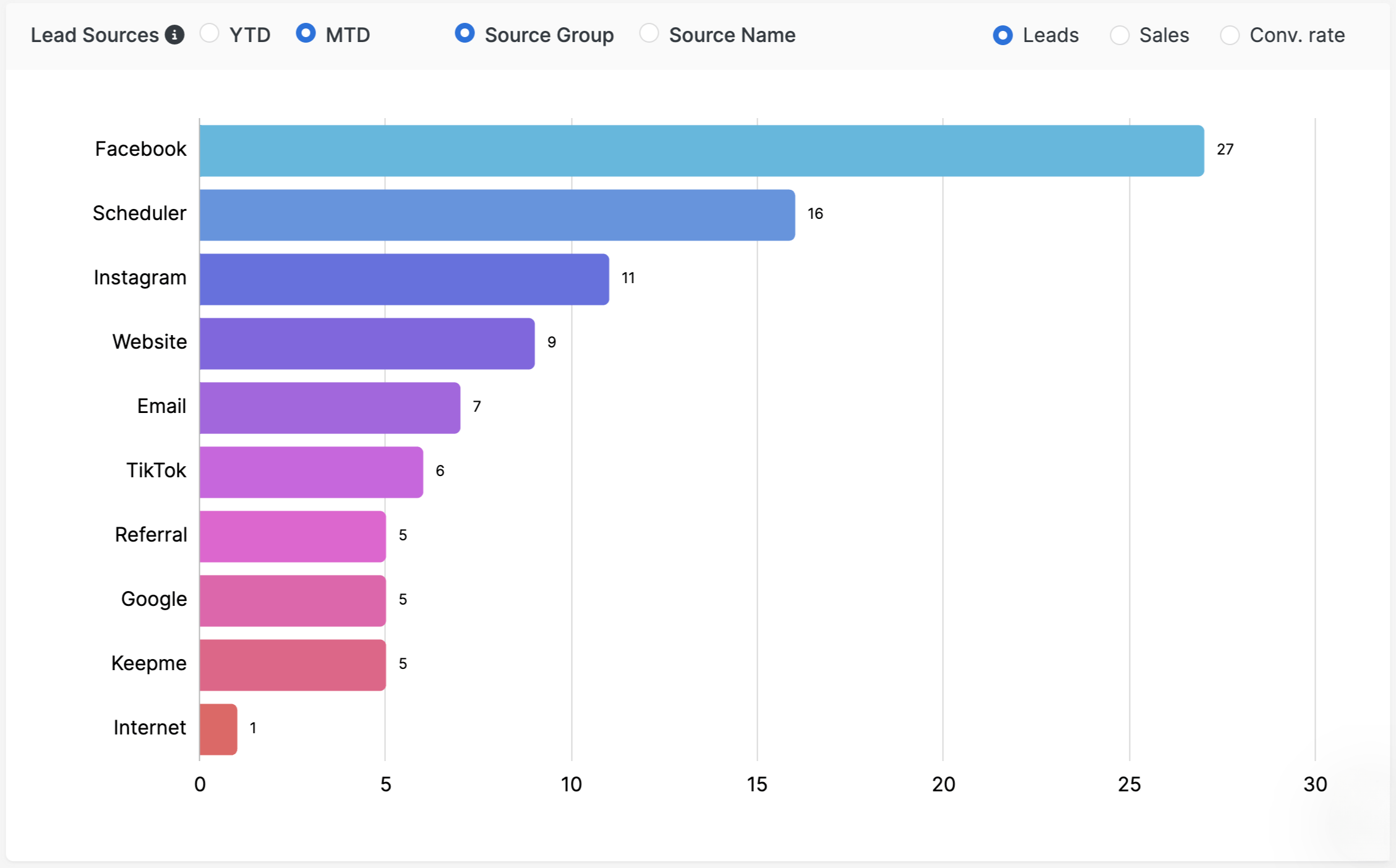No Data Scientist Required: Smart Gym Lead Scoring


The gym industry is fiercely competitive, characterized by a landscape where differentiation is paramount for survival. With a plethora of fitness options available to consumers, gyms vie not only for memberships but for sustained engagement and loyalty. It is precisely because of this fiercely competitive landscape and the level of effort required by facilities at every stage of the member journey, that we should examine how we navigate the very beginning of that journey - the lead.
Lead scoring holds immense relevance as it streamlines the sales process, enhances targeting precision, and maximizes conversion rates. By leveraging lead scoring mechanisms, gym operators can tailor their marketing efforts, personalize communications, and provide targeted incentives, ultimately nurturing leads into loyal, long-term members.
Understanding Lead Scoring
What is Lead Scoring?
We’ve established that lead scoring is a pivotal component of the sales and marketing process, but how do we define it? In short, lead scoring is a systematic method for evaluating and ranking leads based on their likelihood to convert into customers. It involves assigning numerical values (scores) to leads based on various factors such as source, behavior, and engagement level. The primary role of lead scoring is to prioritize and segment leads, allowing sales and marketing teams to focus their efforts on leads that exhibit the highest potential for conversion.
How does Lead Scoring work?
Lead scoring begins with analyzing interactions and attributes throughout the buyer's journey and considering various factors such as website visits, email opens, form submissions, etc. Each interaction is assigned a numerical score based on its perceived importance or relevance to the buying process.
To take some simple examples, you might assign 50 points to a new lead knowing that time is of the essence when it comes to conversion, and deduct 10 points for every week that passes as the lead gets colder. If your best converting leads come from referrals, this could add 5 points; opening an email within the last week might also add 5 points; attending an intro session could add 20 points; failure to engage in any way could deduct 10 points. Thinking about the journey of a lead before they join your gym and how their score could go up or down based on these few rules and you’ll probably come up with some lead scoring rules of your own quite easily.
By combining these interactions and attributes, lead scoring generates a comprehensive view of each lead's engagement level and quality, enabling sales and marketing teams to prioritize follow-up activities and tailor their outreach efforts accordingly.
Why is Lead Scoring important?
Lead scoring is crucial for identifying high-quality leads as it helps your sales and marketing teams prioritize their efforts towards prospects most likely to convert. By assigning scores based on lead behavior and attributes, you can distinguish between leads at different stages of the buying journey and allocate resources effectively. High-scoring leads exhibit stronger engagement and alignment with ideal customer profiles, indicating a greater likelihood of conversion. This process streamlines the sales funnel, increases efficiency, and maximizes ROI by focusing attention on prospects with the highest potential for conversion, ultimately driving revenue growth and fostering the right long-term customer relationships.
The Benefits of Lead Scoring for Gyms
Implementing Lead Scoring in Gyms
Implementing lead scoring in your gym means considering the following four pillars:
Data Collection and Analysis:
Fundamental in lead scoring, collection of high quality data from diverse touch points enables gym operators to gauge leads effectively by aiding in understanding prospects' preferences and behavior. Think about the data points you want to record - what was the source of this lead and when, i.e. how new is it? What behavior can you record - has the lead been in contact more than once, repeatedly opened your email, or signed up for content? Perhaps they’ve expressed interest in a specific discipline or signed up for a trial? Essentially you’re looking for information and behaviors you can easily record and measure.
Developing Lead Scoring Criteria:
Having established what data you’re using to inform your lead scoring, you need to set some benchmarks and begin assigning values to the data. For example you might be considering a mixture of demographic details, online interactions, engagement levels, and time decay. You’ll need to break these down and assign scores accordingly. Demographic details like interests or location may display commonality that suggest a potential member is a good fit and more likely to join based on your existing membership. Online interactions and engagement levels can be scored a little more simply in that higher interaction and engagement is always going to mean a higher score, while time decay is equally straightforward, but works in the opposite direction - the higher the amount of time elapsed since acquiring the lead, the lower the score should be.
Integration with CRM Systems:
Explore whether your lead scoring is something you can integrate with any existing sales or CRM platforms you have in place, to hopefully do some of the heavy lifting for you around the data. Anything you can do to streamline your lead management adds further efficiency to your sales process, as a minimum you should be able to create some reports that gather your data for you in bulk to help you segment leads based on your scores.
Continuous Optimization
Rinse and repeat! What works well today will inevitably change over time, your lead scoring process will require constant monitoring and refinement to adapt to evolving market dynamics and consumer behavior. This iterative process enhances lead scoring accuracy, enabling gyms to prioritize resources efficiently and maximize conversions.
With comprehensive data analysis, well-defined criteria, CRM integration, and continuous optimization, gyms can enhance their lead scoring processes, driving success in sales and marketing efforts while fostering stronger relationships with potential members.
Challenges and Considerations
Lead scoring in the fitness industry presents several challenges and pitfalls. One common issue is the lack of accurate data due to incomplete lead profiles or outdated information. This can lead to inaccurate lead scoring and misallocation of resources. Additionally, the complexity of consumer behavior in the fitness industry poses a challenge, as leads may exhibit varying levels of engagement and interest.
To overcome these challenges, gyms should prioritize data accuracy by regularly updating lead profiles and ensuring all relevant information is collected. Implementing a dynamic lead scoring model that adapts to changing consumer behavior can also improve accuracy. Moreover, integrating lead scoring systems with your sales platform enables seamless data management and enhances lead tracking capabilities.
Furthermore, continuous refinement of lead scoring criteria based on feedback and performance analysis can optimize the effectiveness of the scoring process. If this sounds like a lot of work, keep the benefits in mind - time spent on lead scoring arms your sales team with leads of the best quality at the right time, removing guesswork and delivering higher conversion rates.
The whole process highlights the importance of alignment within the business. For some, sales and marketing will be the same individual or team. However, where they both exist as functions within a gym business, fostering collaboration between sales and marketing teams ensures alignment in lead scoring strategies and facilitates the sharing of insights for continuous improvement.
What if your Gym CRM could tell you how to win more members?
If all of the above is painting a picture of a whole extra role in your team for a data scientist, it’s fair to say that this is certainly an option employed by some facilities. This does not have to be the answer. By managing and scoring your leads in one place, Keepme can help you overcome all these challenges in a single blow without the need for a technical team member to operate it. In fact, by plugging into your member management system and analyzing your existing data, Keepme not only scores your leads, but automates and personalizes your sales outreach and predicts the future of your sales funnel.
Lead Scoring with Keepme - Data Science for Non-Technical Users
Lead scoring in Keepme
Lead scoring is a vital component of Keepme’s comprehensive sales features, let’s take a look at how the platform covers all of the work above for you every day, in just one component of one feature, of a user-friendly platform.
How does lead scoring work in Keepme?
With Keepme, lead scoring comes as standard, giving you all the benefits (and some more that we added) but with none of the manual work above. So how does lead scoring in Keepme compare with manual efforts or other solutions? Let’s take a look at how Keepme arrives at the scores you can so easily review in your Sales Dashboard each day.
Predictive Analysis:
Machine learning continuously analyzes historical data and ideal customer profiles within your lead data. This analysis predicts whether a lead matches optimal user types likely to join your facility.
Engagement Metrics:
The AI assesses various metrics, including the source of the lead, website visits, completed forms, and engagement actions. These interactions provide valuable data to determine the probability of a lead joining.
Assigning Values:
Leads receive scores based on their interactions. For example, a lead booking a tour receives a higher score due to an increased likelihood of joining. The more engaged the lead, the higher the score, indicating a stronger possibility of conversion.
The Calculation
Having considered all of the above, the following calculation is then applied to every lead to create a lead quality score:
All leads begin with a score of 100.
The primary factor influencing lead score is time decay: the number of days since the lead was created (Older leads = lower score).
Then any engagement with the lead in the last 30 days.
And time elapsed since the last contact with the lead is also considered.
Conversion rates are analyzed based on the manager, source group, and gender in the last 90 days.
What does the score look like?
With all leads automatically assessed to generate a lead score, with Keepme you can view your ‘Strength Buckets’ and their corresponding scores on your dashboard.
 Strength Buckets:
Strength Buckets:
Strength buckets categorize leads based on their scores, giving you an at-a-glance update of how many leads you have and the quality across the full spread.
Blue Bucket: Your total number of leads for the current month, including your current average lead score and a brief breakdown of your leads.
Strong score (Green Bucket): These are your leads with the highest probability of joining.
Medium score (Amber Bucket): These leads represent an opportunity and should be engaged promptly.
Weak score (Red Bucket): These leads would require additional qualification, further assessment would be recommended before dedicating time to tours or trials.
Sales Dashboard
All this and more is contained within the Keepme Sales Dashboard, alongside a host of other actionable data. One more item we should consider without delving into a whole other blog, is lead sources. It’s important to remember that with Keepme, all leads are collected and captured in the platform, whatever the source. This includes website forms, social media, and walk-ins to name but a few, captured through form stacks and webhooks integrated to ensure comprehensive lead tracking.
 From a strategic point of view, this creates another hugely valuable and live source of data, telling you which sources are bringing in the most leads, and which leads are coming in hot or cold, allowing you to structure your marketing efforts based on solid information.
From a strategic point of view, this creates another hugely valuable and live source of data, telling you which sources are bringing in the most leads, and which leads are coming in hot or cold, allowing you to structure your marketing efforts based on solid information.
Lead scoring is vital for maximizing gym memberships by efficiently identifying and prioritizing high-quality leads. Through data-driven analysis, gyms can assign scores to leads based on their interactions and attributes, allowing them to focus resources on prospects most likely to convert, and use automation to template and personalize repetitive messages, freeing up resource for other stages of the member journey.
.png)
Embracing lead scoring as a strategic tool is paramount for gyms aiming to drive growth, fortify customer relationships, and remain competitive in the fitness industry. By leveraging lead scoring methodologies, gyms can not only enhance the efficiency of their marketing efforts, but also improve the overall customer experience. In a competitive landscape where customer expectations continue to evolve, lead scoring provides gyms with actionable insights to adapt their marketing strategies and stay ahead of the curve.
Ultimately, by embracing lead scoring as a core component of their business strategy, gyms can unlock new avenues for growth, make the best use of their resources,, and solidify their position in the fitness market.
With Keepme as your data scientist, anyone can get actionable insights from their leads, while automations can deliver personalized campaigns so that no opportunity is ever missed. This bulletproof strategy can be employed as part of a host of smart features without the need for technical users on your team, freeing up your team to improve your members’ experiences to drive engagement and retention.
To learn more about how Keepme could help your team do their best work, book a discovery call and see for yourself the full suite of tools at the fingers of Keepme users.

Ready to learn how Keepme can help?
Book a discovery call for a time that suits you and we'll show you how Keepme can be the Data Scientist in your back pocket.






